Business and Corporations Law: Analysis of Contract Law Scenarios
VerifiedAdded on 2023/01/10
|5
|1346
|62
Case Study
AI Summary
This assignment is a case study analyzing several contract law issues faced by a used car business owner named Dan. The scenarios involve Mary and Dan's potential contract for a Honda Jazz sale complicated by a mutual mistake about the car's color, Michael and Dan's contract for a Toyota truck, with a question of offer revocation, Gordon and Dan's contract for a truck sale complicated by Dan's unilateral mistake, and Edgar and Dan's potential contract for a Holden Statesman, where a price sticker is involved. The analysis applies contract law principles, including mutual and unilateral mistake, the postal rule for acceptance, and the concept of 'invitation to treat,' referencing relevant legal precedents. The conclusion provides a determination on the enforceability of each contract based on the facts and legal principles applied.
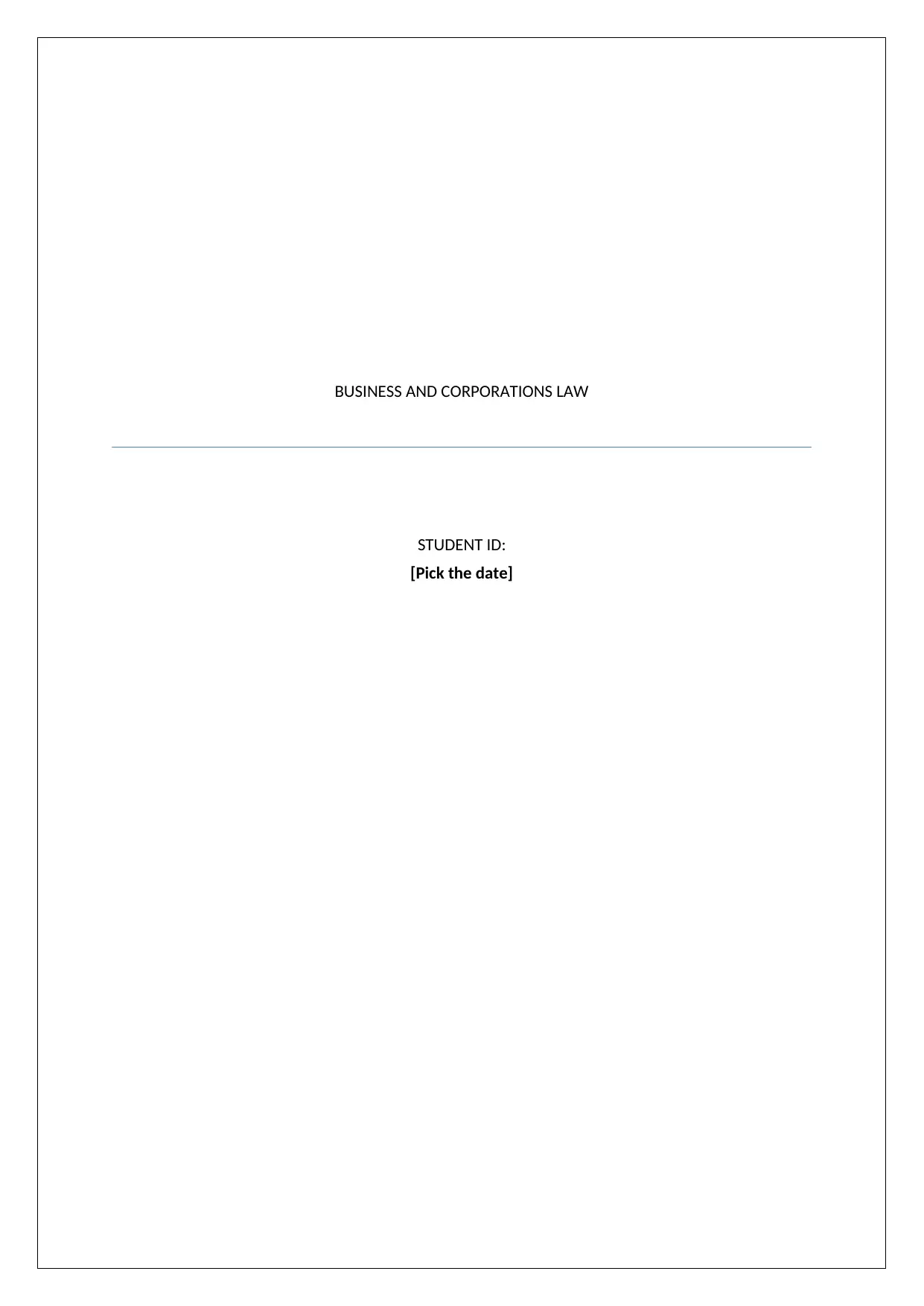
BUSINESS AND CORPORATIONS LAW
STUDENT ID:
[Pick the date]
STUDENT ID:
[Pick the date]
Paraphrase This Document
Need a fresh take? Get an instant paraphrase of this document with our AI Paraphraser
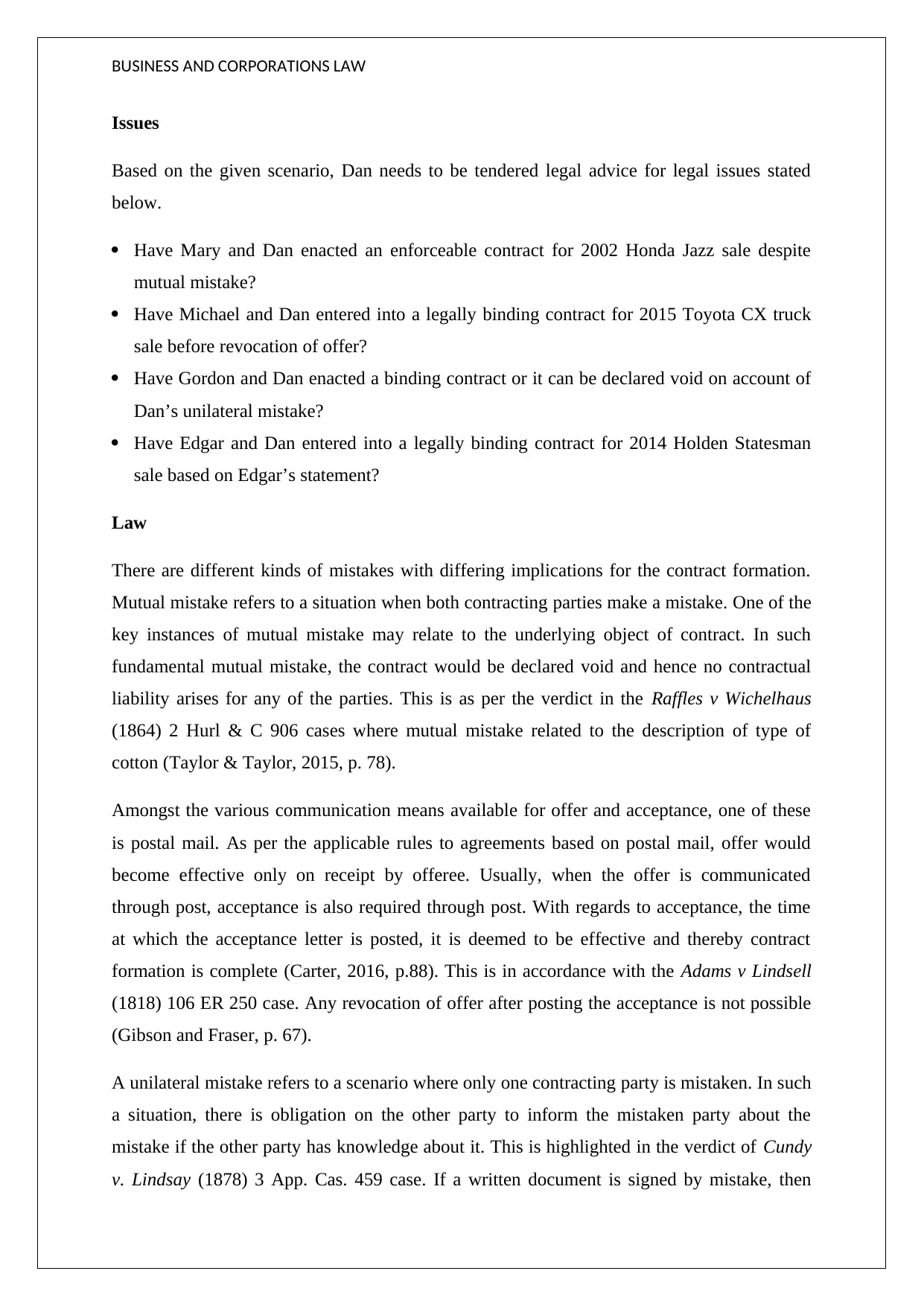
BUSINESS AND CORPORATIONS LAW
Issues
Based on the given scenario, Dan needs to be tendered legal advice for legal issues stated
below.
Have Mary and Dan enacted an enforceable contract for 2002 Honda Jazz sale despite
mutual mistake?
Have Michael and Dan entered into a legally binding contract for 2015 Toyota CX truck
sale before revocation of offer?
Have Gordon and Dan enacted a binding contract or it can be declared void on account of
Dan’s unilateral mistake?
Have Edgar and Dan entered into a legally binding contract for 2014 Holden Statesman
sale based on Edgar’s statement?
Law
There are different kinds of mistakes with differing implications for the contract formation.
Mutual mistake refers to a situation when both contracting parties make a mistake. One of the
key instances of mutual mistake may relate to the underlying object of contract. In such
fundamental mutual mistake, the contract would be declared void and hence no contractual
liability arises for any of the parties. This is as per the verdict in the Raffles v Wichelhaus
(1864) 2 Hurl & C 906 cases where mutual mistake related to the description of type of
cotton (Taylor & Taylor, 2015, p. 78).
Amongst the various communication means available for offer and acceptance, one of these
is postal mail. As per the applicable rules to agreements based on postal mail, offer would
become effective only on receipt by offeree. Usually, when the offer is communicated
through post, acceptance is also required through post. With regards to acceptance, the time
at which the acceptance letter is posted, it is deemed to be effective and thereby contract
formation is complete (Carter, 2016, p.88). This is in accordance with the Adams v Lindsell
(1818) 106 ER 250 case. Any revocation of offer after posting the acceptance is not possible
(Gibson and Fraser, p. 67).
A unilateral mistake refers to a scenario where only one contracting party is mistaken. In such
a situation, there is obligation on the other party to inform the mistaken party about the
mistake if the other party has knowledge about it. This is highlighted in the verdict of Cundy
v. Lindsay (1878) 3 App. Cas. 459 case. If a written document is signed by mistake, then
Issues
Based on the given scenario, Dan needs to be tendered legal advice for legal issues stated
below.
Have Mary and Dan enacted an enforceable contract for 2002 Honda Jazz sale despite
mutual mistake?
Have Michael and Dan entered into a legally binding contract for 2015 Toyota CX truck
sale before revocation of offer?
Have Gordon and Dan enacted a binding contract or it can be declared void on account of
Dan’s unilateral mistake?
Have Edgar and Dan entered into a legally binding contract for 2014 Holden Statesman
sale based on Edgar’s statement?
Law
There are different kinds of mistakes with differing implications for the contract formation.
Mutual mistake refers to a situation when both contracting parties make a mistake. One of the
key instances of mutual mistake may relate to the underlying object of contract. In such
fundamental mutual mistake, the contract would be declared void and hence no contractual
liability arises for any of the parties. This is as per the verdict in the Raffles v Wichelhaus
(1864) 2 Hurl & C 906 cases where mutual mistake related to the description of type of
cotton (Taylor & Taylor, 2015, p. 78).
Amongst the various communication means available for offer and acceptance, one of these
is postal mail. As per the applicable rules to agreements based on postal mail, offer would
become effective only on receipt by offeree. Usually, when the offer is communicated
through post, acceptance is also required through post. With regards to acceptance, the time
at which the acceptance letter is posted, it is deemed to be effective and thereby contract
formation is complete (Carter, 2016, p.88). This is in accordance with the Adams v Lindsell
(1818) 106 ER 250 case. Any revocation of offer after posting the acceptance is not possible
(Gibson and Fraser, p. 67).
A unilateral mistake refers to a scenario where only one contracting party is mistaken. In such
a situation, there is obligation on the other party to inform the mistaken party about the
mistake if the other party has knowledge about it. This is highlighted in the verdict of Cundy
v. Lindsay (1878) 3 App. Cas. 459 case. If a written document is signed by mistake, then
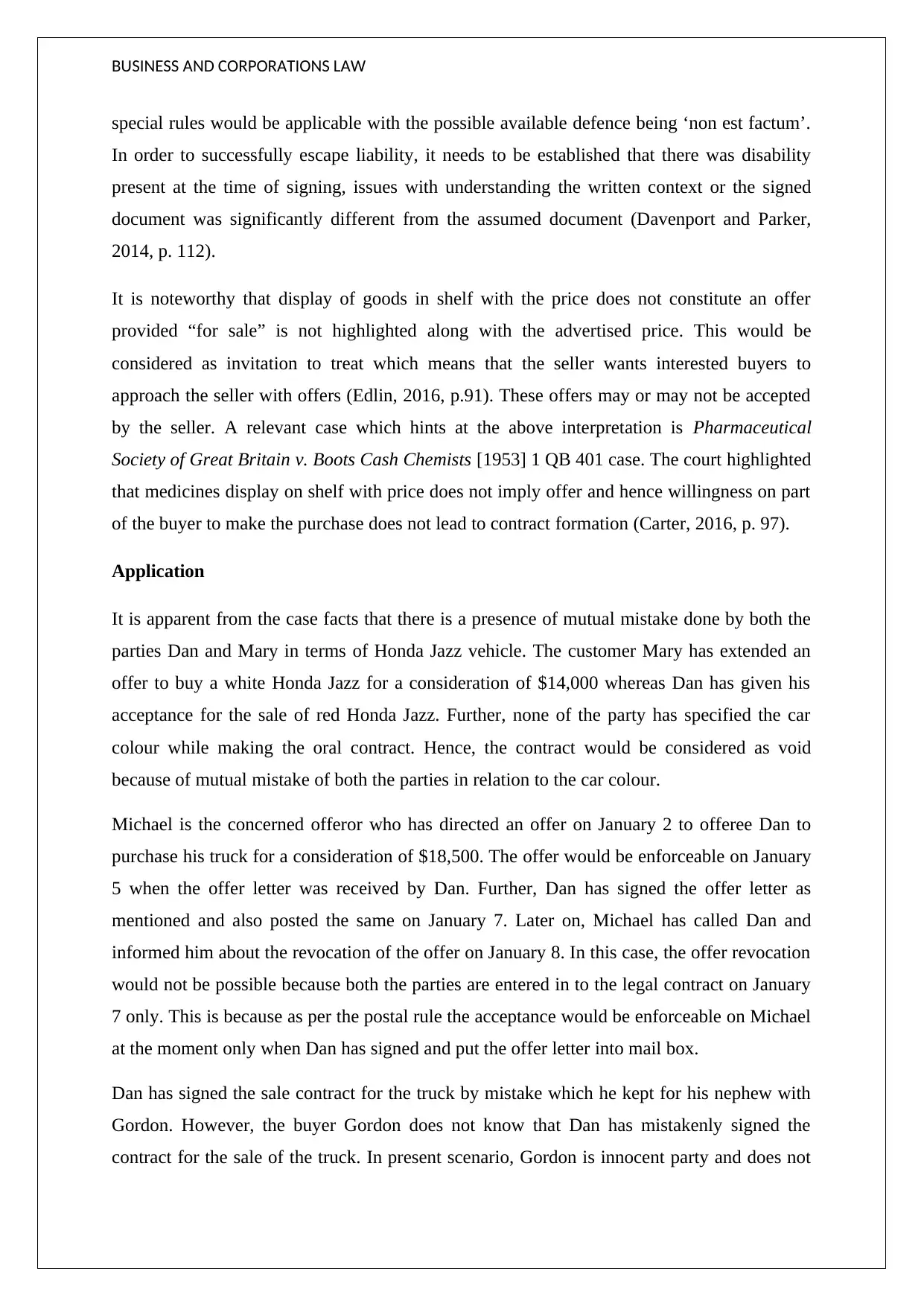
BUSINESS AND CORPORATIONS LAW
special rules would be applicable with the possible available defence being ‘non est factum’.
In order to successfully escape liability, it needs to be established that there was disability
present at the time of signing, issues with understanding the written context or the signed
document was significantly different from the assumed document (Davenport and Parker,
2014, p. 112).
It is noteworthy that display of goods in shelf with the price does not constitute an offer
provided “for sale” is not highlighted along with the advertised price. This would be
considered as invitation to treat which means that the seller wants interested buyers to
approach the seller with offers (Edlin, 2016, p.91). These offers may or may not be accepted
by the seller. A relevant case which hints at the above interpretation is Pharmaceutical
Society of Great Britain v. Boots Cash Chemists [1953] 1 QB 401 case. The court highlighted
that medicines display on shelf with price does not imply offer and hence willingness on part
of the buyer to make the purchase does not lead to contract formation (Carter, 2016, p. 97).
Application
It is apparent from the case facts that there is a presence of mutual mistake done by both the
parties Dan and Mary in terms of Honda Jazz vehicle. The customer Mary has extended an
offer to buy a white Honda Jazz for a consideration of $14,000 whereas Dan has given his
acceptance for the sale of red Honda Jazz. Further, none of the party has specified the car
colour while making the oral contract. Hence, the contract would be considered as void
because of mutual mistake of both the parties in relation to the car colour.
Michael is the concerned offeror who has directed an offer on January 2 to offeree Dan to
purchase his truck for a consideration of $18,500. The offer would be enforceable on January
5 when the offer letter was received by Dan. Further, Dan has signed the offer letter as
mentioned and also posted the same on January 7. Later on, Michael has called Dan and
informed him about the revocation of the offer on January 8. In this case, the offer revocation
would not be possible because both the parties are entered in to the legal contract on January
7 only. This is because as per the postal rule the acceptance would be enforceable on Michael
at the moment only when Dan has signed and put the offer letter into mail box.
Dan has signed the sale contract for the truck by mistake which he kept for his nephew with
Gordon. However, the buyer Gordon does not know that Dan has mistakenly signed the
contract for the sale of the truck. In present scenario, Gordon is innocent party and does not
special rules would be applicable with the possible available defence being ‘non est factum’.
In order to successfully escape liability, it needs to be established that there was disability
present at the time of signing, issues with understanding the written context or the signed
document was significantly different from the assumed document (Davenport and Parker,
2014, p. 112).
It is noteworthy that display of goods in shelf with the price does not constitute an offer
provided “for sale” is not highlighted along with the advertised price. This would be
considered as invitation to treat which means that the seller wants interested buyers to
approach the seller with offers (Edlin, 2016, p.91). These offers may or may not be accepted
by the seller. A relevant case which hints at the above interpretation is Pharmaceutical
Society of Great Britain v. Boots Cash Chemists [1953] 1 QB 401 case. The court highlighted
that medicines display on shelf with price does not imply offer and hence willingness on part
of the buyer to make the purchase does not lead to contract formation (Carter, 2016, p. 97).
Application
It is apparent from the case facts that there is a presence of mutual mistake done by both the
parties Dan and Mary in terms of Honda Jazz vehicle. The customer Mary has extended an
offer to buy a white Honda Jazz for a consideration of $14,000 whereas Dan has given his
acceptance for the sale of red Honda Jazz. Further, none of the party has specified the car
colour while making the oral contract. Hence, the contract would be considered as void
because of mutual mistake of both the parties in relation to the car colour.
Michael is the concerned offeror who has directed an offer on January 2 to offeree Dan to
purchase his truck for a consideration of $18,500. The offer would be enforceable on January
5 when the offer letter was received by Dan. Further, Dan has signed the offer letter as
mentioned and also posted the same on January 7. Later on, Michael has called Dan and
informed him about the revocation of the offer on January 8. In this case, the offer revocation
would not be possible because both the parties are entered in to the legal contract on January
7 only. This is because as per the postal rule the acceptance would be enforceable on Michael
at the moment only when Dan has signed and put the offer letter into mail box.
Dan has signed the sale contract for the truck by mistake which he kept for his nephew with
Gordon. However, the buyer Gordon does not know that Dan has mistakenly signed the
contract for the sale of the truck. In present scenario, Gordon is innocent party and does not
⊘ This is a preview!⊘
Do you want full access?
Subscribe today to unlock all pages.

Trusted by 1+ million students worldwide
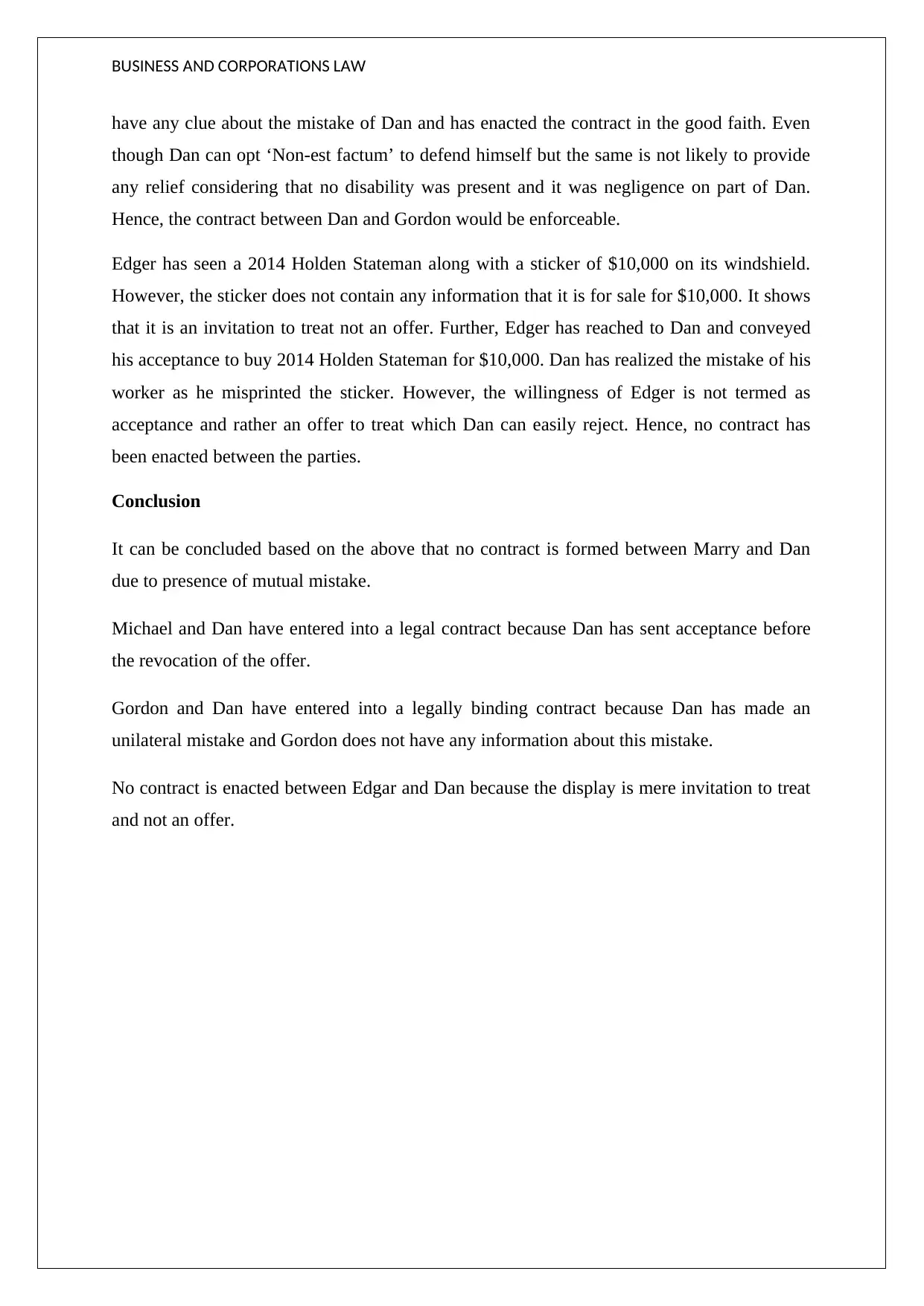
BUSINESS AND CORPORATIONS LAW
have any clue about the mistake of Dan and has enacted the contract in the good faith. Even
though Dan can opt ‘Non-est factum’ to defend himself but the same is not likely to provide
any relief considering that no disability was present and it was negligence on part of Dan.
Hence, the contract between Dan and Gordon would be enforceable.
Edger has seen a 2014 Holden Stateman along with a sticker of $10,000 on its windshield.
However, the sticker does not contain any information that it is for sale for $10,000. It shows
that it is an invitation to treat not an offer. Further, Edger has reached to Dan and conveyed
his acceptance to buy 2014 Holden Stateman for $10,000. Dan has realized the mistake of his
worker as he misprinted the sticker. However, the willingness of Edger is not termed as
acceptance and rather an offer to treat which Dan can easily reject. Hence, no contract has
been enacted between the parties.
Conclusion
It can be concluded based on the above that no contract is formed between Marry and Dan
due to presence of mutual mistake.
Michael and Dan have entered into a legal contract because Dan has sent acceptance before
the revocation of the offer.
Gordon and Dan have entered into a legally binding contract because Dan has made an
unilateral mistake and Gordon does not have any information about this mistake.
No contract is enacted between Edgar and Dan because the display is mere invitation to treat
and not an offer.
have any clue about the mistake of Dan and has enacted the contract in the good faith. Even
though Dan can opt ‘Non-est factum’ to defend himself but the same is not likely to provide
any relief considering that no disability was present and it was negligence on part of Dan.
Hence, the contract between Dan and Gordon would be enforceable.
Edger has seen a 2014 Holden Stateman along with a sticker of $10,000 on its windshield.
However, the sticker does not contain any information that it is for sale for $10,000. It shows
that it is an invitation to treat not an offer. Further, Edger has reached to Dan and conveyed
his acceptance to buy 2014 Holden Stateman for $10,000. Dan has realized the mistake of his
worker as he misprinted the sticker. However, the willingness of Edger is not termed as
acceptance and rather an offer to treat which Dan can easily reject. Hence, no contract has
been enacted between the parties.
Conclusion
It can be concluded based on the above that no contract is formed between Marry and Dan
due to presence of mutual mistake.
Michael and Dan have entered into a legal contract because Dan has sent acceptance before
the revocation of the offer.
Gordon and Dan have entered into a legally binding contract because Dan has made an
unilateral mistake and Gordon does not have any information about this mistake.
No contract is enacted between Edgar and Dan because the display is mere invitation to treat
and not an offer.
Paraphrase This Document
Need a fresh take? Get an instant paraphrase of this document with our AI Paraphraser
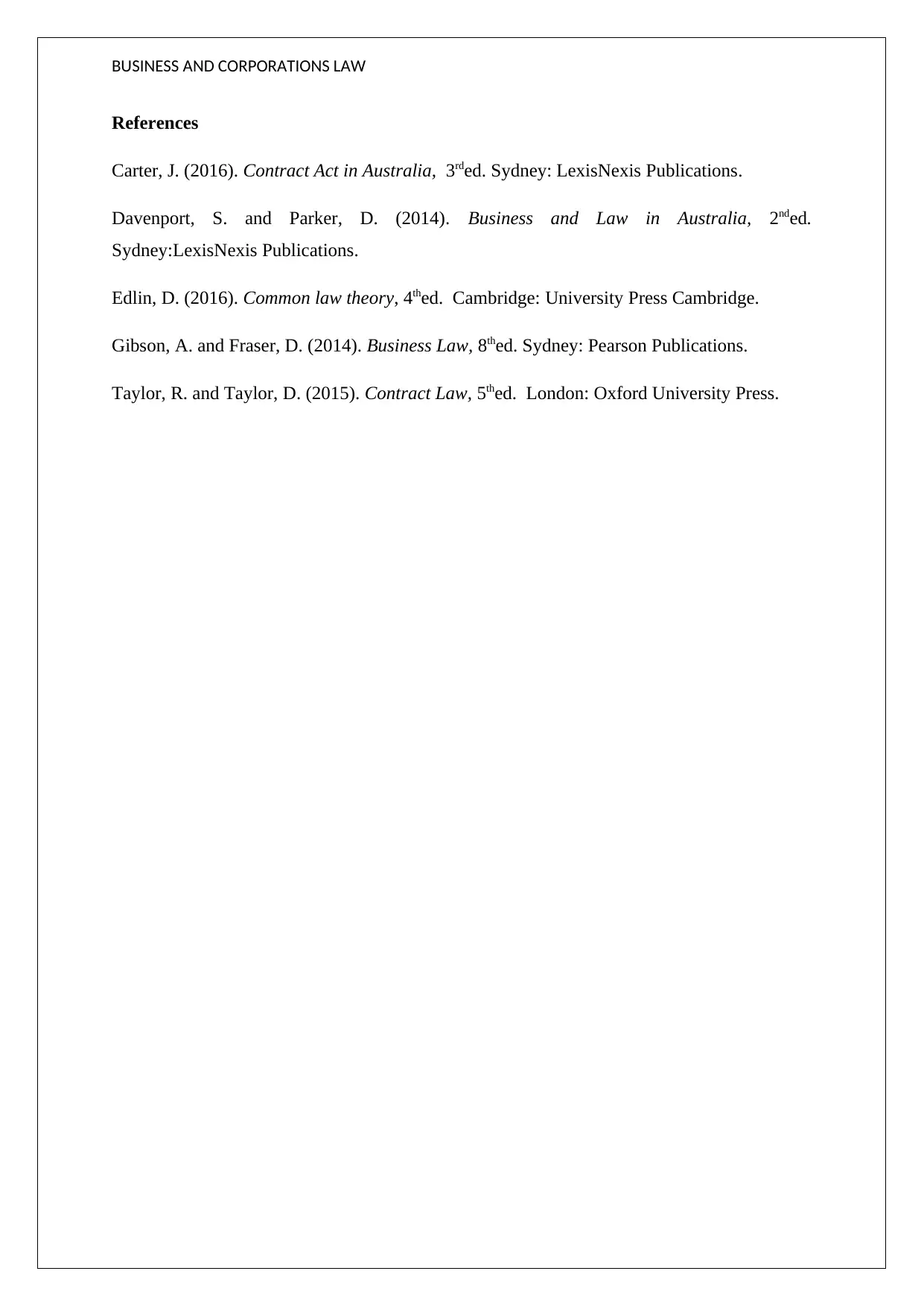
BUSINESS AND CORPORATIONS LAW
References
Carter, J. (2016). Contract Act in Australia, 3rded. Sydney: LexisNexis Publications.
Davenport, S. and Parker, D. (2014). Business and Law in Australia, 2nded.
Sydney:LexisNexis Publications.
Edlin, D. (2016). Common law theory, 4thed. Cambridge: University Press Cambridge.
Gibson, A. and Fraser, D. (2014). Business Law, 8thed. Sydney: Pearson Publications.
Taylor, R. and Taylor, D. (2015). Contract Law, 5thed. London: Oxford University Press.
References
Carter, J. (2016). Contract Act in Australia, 3rded. Sydney: LexisNexis Publications.
Davenport, S. and Parker, D. (2014). Business and Law in Australia, 2nded.
Sydney:LexisNexis Publications.
Edlin, D. (2016). Common law theory, 4thed. Cambridge: University Press Cambridge.
Gibson, A. and Fraser, D. (2014). Business Law, 8thed. Sydney: Pearson Publications.
Taylor, R. and Taylor, D. (2015). Contract Law, 5thed. London: Oxford University Press.
1 out of 5
Related Documents
Your All-in-One AI-Powered Toolkit for Academic Success.
+13062052269
info@desklib.com
Available 24*7 on WhatsApp / Email
![[object Object]](/_next/static/media/star-bottom.7253800d.svg)
Unlock your academic potential
Copyright © 2020–2025 A2Z Services. All Rights Reserved. Developed and managed by ZUCOL.




